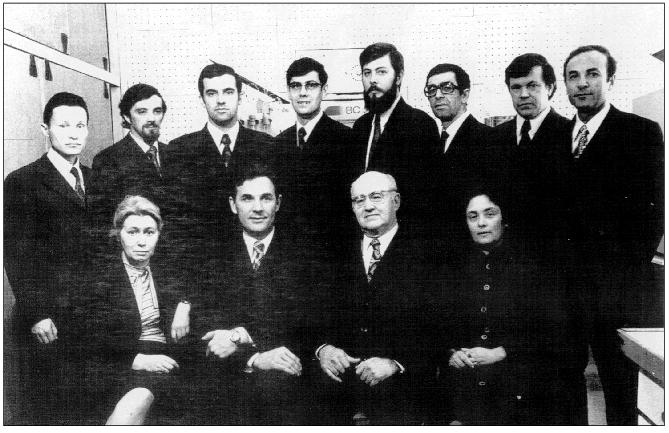The Enzyme of the Life of Alexander Evseevich Braunstein (commemorating the 30th anniversary of the determination of the primary structure of aspartate aminotransferase)
Ts. A. Egorov
Shemyakin and Ovchinnikov Institute of Bioorganic Chemistry, Russian Academy of Sciences, ul. Miklukho-Maklaya 16/10, Moscow, 117198 Russia; fax: (095) 310-7007Received May 15, 2002
I got acquainted with Alexander Evseevich Braunstein in 1965. He was a true scientist, a nice and intelligent person, who often helped me in difficult situations. Our close scientific cooperation began with the analysis of the primary structure of the cytoplasmic aspartate aminotransferase (AAT) from pig heart. My involvement in this research project coincided with my acquaintance with Oleg Polyanovskii in 1962 when both of us worked at the Institute of Organic Chemistry and Biochemistry of the Czechoslovakian Academy of Sciences in Prague. However, our real scientific collaboration started after I got my PhD degree in 1965. Taking into account the complexity of the work (the molecular weight of the protein is about 50 kD), it was necessary to create an actively working team of scientists. Thus we invited Anatolii Kiryushkin from the laboratory of Yu. A. Ovchinnikov who worked on mass spectrometry of peptides. Mikhail Mikhailovich Shemyakin, the head of the institute, approved his participation in the project. He also included the group of E. I. Vinogradova (N. A. Aldanova, M. Yu. Feigina, and V. M. Lipkin) from his own laboratory in the research team. In 1967, several PhD students and young scientists from the Laboratory of Peptide Chemistry (N. N. Modyanov, N. G. Abdulaev, A. P. Kiselev, and E. V. Grishin) joined the research team. The group of Oleg Polyanovskii consisted of Valerii Nosikov and a technician. As a result, four groups were formed (those of Polyanovskii, Egorov, Kiryushkin, and Vinogradova). The whole project was supervised by Braunstein and Shemyakin and after Shemyakin's death in 1970, by Yurii Ovchinnikov. Polyanovskii was responsible for the isolation of the protein and its cleavage with cyanogen bromide. In my group, the AAT was digested with different enzymes, and the obtained peptides were separated by chromatography and their amino acid composition was determined. (In Czechoslovakia, I learned quite a lot about protein structure analysis and became quite an expert in this field). The groups of Vinogradova and Kiryushkin determined the structure of peptides by chemical and mass spectrometric methods, respectively. At the beginning, the work progressed successfully, although most stages of the primary structure determination were performed manually. For example, the chromatography of peptides took more than 50 h, and their detection by ninhydrin occupied several days. Later, due to automation, we managed to reduce the time of analysis to several hours.
Our first results were presented in 1969 at the 1st All-Union Biochemical Congress (Tashkent), the 7th International Symposium on the Chemistry of Natural Compounds (Riga, 1970), at the 7th FEBO Conference (Varna, 1971). The results of the work were partially published in FEBS Letters in 1971. Later, the institute got new high-speed amino acid analyzers (we made up to 50 analyses per day) and a protein sequencer. However, considerable difficulties were encountered in locating peptides in a polypeptide chain of the enzyme. Finally, the structure of AAT consisting of 412 amino acid residues was reconstructed as in dominoes. This event occurred after the celebration of the 70th birthday of Alexander Evseevich, who was greatly interested in the progress of the research, especially in the position of pyridoxal phosphate, the size of the polypeptide chain, etc. The work was rapidly published in the Doklady Akademii Nauk due to the support of Academician A. A. Baev, who was the chief editor of the journal at that time, and then in FEBS Letters. To confirm the obtained sequence, it was necessary to perform additional experiments; this took another two years. The results were summarized in 14 papers published in Biokhimiya (1972-1975). The final paper with the complete amino acid sequence of AAT appeared in 1974. The determination of the complete amino acid sequence of AAT was a great success in biochemistry. For the first time, the primary structure of a pyridoxal-containing enzyme was elucidated. However, the work was rewarded only with the Leninskii Komsomol award: five young scientists were awarded, although many experienced scientists played an important (key) role in the realization of the project (see the photo of the main participants of the project). After the work was completed, I continued my cooperation with the laboratory of Braunstein on the identification of functionally important amino acids and was a coauthor of several publications. The experience obtained in this work was successfully used in further studies of the primary structure of other complex proteins and AAT from chicken heart. In the group of Sergei Shlyapnikov (Institute of Molecular Biology of the Russian Academy of Sciences), the primary structure of the enzyme from chicken heart was determined. Valentina Kochkina (Institute of Molecular Biology of the Russian Academy of Sciences) obtained the crystals of the enzyme, and the three-dimensional structure of AAT was resolved in the Institute of Crystallography of the Russian Academy of Sciences. Thus, the dream of Alexander Evseevich came true: in our country, AAT was sequenced, and the three-dimensional model of the enzyme was reconstructed, allowing the beginning more detailed investigations of the enzyme.
The main participants of the project on AAT primary structure determination. Sitting (from left to right): M. Yu. Feigina, Yu. A. Ovchinnikov, A. E. Braunstein, and N. A. Aldanova. Standing (from left to right): Ts. A. Egorov, A. P. Kiselev, E. V. Grishin, V. M. Lipkin, V. V. Nosikov, N. G. Abdulaev, N. N. Modyanov, O. L. Polyanovskii
